Hierarchical Statistics-Based Nonlinear Vertical Velocity Distribution of Debris Flow and Its Application in Entrainment Estimation
Abstract
:1. Introduction
2. Model and Methodology
2.1. HBP-SPH Numerical Simulation Method
2.2. Particle Hierarchical Statistical Algorithm
3. Numerical Simulation of Flume Test of Large Debris Flow
3.1. HBP-SPH Numerical Simulation
3.2. Velocity Profile Result
4. Nonlinear Model of Vertical Distribution of Velocity
4.1. Flow Velocity Distribution Fitting Equation
4.2. Parameter Analysis of the Fitting Equation
5. Application in Entrainment Estimation
6. Discussion
6.1. Time Evolution of Velocity Profiles
6.2. Uniform Particle Simplification
7. Conclusions
Author Contributions
Funding
Institutional Review Board Statement
Informed Consent Statement
Data Availability Statement
Conflicts of Interest
References
- Iverson, R.M.; Reid, M.E.; Logan, M.; LaHusen, R.G.; Godt, J.W.; Griswold, J.P. Positive feedback and momentum growth during debris-flow entrainment of wet bed sediment. Nat. Geosci. 2011, 4, 116–121. [Google Scholar] [CrossRef]
- Johnson, C.G.; Kokelaar, B.P.; Iverson, R.M.; Logan, M.; LaHusen, R.G.; Gray, J.M.N.T. Grain-size segregation and levee formation in geophysical mass flows. J. Geophys. Res.-Earth Surf. 2012, 117. [Google Scholar] [CrossRef]
- Han, Z.; Ma, Y.; Li, Y.; Zhang, H.; Chen, N.; Hu, G.; Chen, G. Hydrodynamic and topography based cellular automaton model for simulating debris flow run-out extent and entrainment behavior. Water Res. 2021, 193, 116872. [Google Scholar] [CrossRef] [PubMed]
- Iverson, R.M. Elementary theory of bed-sediment entrainment by debris flows and avalanches. J. Geophys. Res.-Earth Surf. 2012, 117. [Google Scholar] [CrossRef]
- Han, Z.; Chen, G.; Li, Y.; Tang, C.; Xu, L.; He, Y.; Wang, W. Numerical simulation of debris-flow behavior incorporating a dynamic method for estimating the entrainment. Eng. Geol. 2015, 190, 52–64. [Google Scholar] [CrossRef]
- He, S.; Liu, W.; Li, X. Prediction of impact force of debris flows based on distribution and size of particles. Environ. Earth Sci. 2016, 75, 1–8. [Google Scholar] [CrossRef]
- Ma, Z.; Zhang, J.; Liao, H. Numerical simulation of viscous debris flow block engineering. Rock Soil Mech. 2007, 28, 389–392. (In Chinese) [Google Scholar] [CrossRef]
- Iverson, R.M.; Vallance, J.W. New views of granular mass flows. Geology 2001, 29, 115–118. [Google Scholar] [CrossRef]
- Tecca, P.R.; Deganutti, A.M.; Genevois, R.; Galgaro, A. Velocity distributions in a coarse debris flow. In Debris-Flow Hazards Mitigation: Mechanics, Prediction, and Assessment, Proceedings of the 3rd International Conference; Rickenmann, D., Chen, C.-L., Eds.; Millpress: Rotterdam, The Netherlands, 2003; pp. 905–916. [Google Scholar]
- Ferguson, R. Flow resistance equations for gravel-and boulder-bed streams. Water Resour. Res. 2007, 43. [Google Scholar] [CrossRef] [Green Version]
- Termini, D.; Fichera, A. Experimental Analysis of Velocity Distribution in a Coarse-Grained Debris Flow: A Modified Bagnold’s Equation. Water 2020, 12, 1415. [Google Scholar] [CrossRef]
- Wei, F.; Yang, H.; Hu, K.; Chernomorets, S. Measuring internal velocity of debris flows by temporally correlated shear forces. J. Earth Sci. 2012, 23, 373–380. [Google Scholar] [CrossRef]
- Takahashi, T. Mechanical characteristics of debris flow. J. Hydraul. Eng. 1978, 104, 1153–1169. [Google Scholar] [CrossRef]
- Takahashi, T. Debris flow on prismatic open channel. J. Hydraul. Eng. 1980, 106, 381–396. [Google Scholar] [CrossRef]
- Egashira, S.; Ashida, K.; Yajima, H.; Takahama, J. Constitutive equation of debris flow. Annu. Disaster Prev. Res. Inst. Kyoto Univ. 1989, 32, 487–501. [Google Scholar]
- Hotta, N.; Miyamoto, K.; Suzuki, M.; Ohta, T. Pore-water pressure distribution of solid-water phase flow in a rolling mill. J. Jpn. Soc. Eros. Cont. Eng. 1998, 50, 11–16. [Google Scholar] [CrossRef]
- Drago, M. A coupled debris flow–turbidity current model. Ocean Eng. 2002, 29, 1769–1780. [Google Scholar] [CrossRef]
- Han, Z.; Chen, G.; Li, Y.; Wang, W.; Zhang, H. Exploring the velocity distribution of debris flows: An iteration algorithm based approach for complex cross-sections. Geomorphology 2015, 241, 72–82. [Google Scholar] [CrossRef]
- Han, Z.; Wang, W.; Li, Y.; Huang, J.; Su, B.; Tang, C.; Qu, X. An integrated method for rapid estimation of the valley incision by debris flows. Eng. Geol. 2018, 232, 34–45. [Google Scholar] [CrossRef]
- Han, Z.; Su, B.; Li, Y.; Dou, J.; Wang, W.; Zhao, L. Modeling the progressive entrainment of bed sediment by viscous debris flows using the three-dimensional SC-HBP-SPH method. Water Res. 2020, 182, 116031. [Google Scholar] [CrossRef]
- Domnik, B.; Pudasaini, S.P. Full two-dimensional rapid chute flows of simple viscoplastic granular materials with a pressure-dependent dynamic slip-velocity and their numerical simulations. J. Non-Newton. Fluid Mech. 2012, 173, 72–86. [Google Scholar] [CrossRef]
- Domnik, B.; Pudasaini, S.P.; Katzenbach, R.; Miller, S.A. Coupling of full two-dimensional and depth-averaged models for granular flows. J. Non-Newton. Fluid Mech. 2013, 201, 56–68. [Google Scholar] [CrossRef]
- Calomino, F.; Alfonsi, G.; Gaudio, R.; D’Ippolito, A.; Lauria, A.; Tafarojnoruz, A.; Artese, S.J.W. Experimental and numerical study of free-surface flows in a corrugated pipe. Water 2018, 10, 638. [Google Scholar] [CrossRef] [Green Version]
- Lauria, A.; Alfonsi, G.; Tafarojnoruz, A.J.F. Flow pressure behavior downstream of ski jumps. Water 2020, 5, 168. [Google Scholar] [CrossRef]
- Tafarojnoruz, A.; Lauria, A. Large eddy simulation of the turbulent flow field around a submerged pile within a scour hole under current condition. Coast Eng. J. 2020, 62, 489–503. [Google Scholar] [CrossRef]
- Huang, Y.; Cheng, H.; Dai, Z.; Xu, Q.; Liu, F.; Sawada, K.; Yashima, A. SPH-based numerical simulation of catastrophic debris flows after the 2008 Wenchuan earthquake. Bull. Eng. Geol. Environ. 2015, 74, 1137–1151. [Google Scholar] [CrossRef]
- Dai, Z.; Huang, Y.; Cheng, H.; Xu, Q. SPH model for fluid–structure interaction and its application to debris flow impact estimation. Landslides 2017, 14, 917–928. [Google Scholar] [CrossRef]
- Wang, W.; Chen, G.; Han, Z.; Zhou, S.; Zhang, H.; Jing, P. 3D numerical simulation of debris-flow motion using SPH method incorporating non-Newtonian fluid behavior. Nat. Hazards 2016, 81, 1981–1998. [Google Scholar] [CrossRef]
- Han, Z.; Su, B.; Li, Y.; Wang, W.; Wang, W.; Huang, J.; Chen, G. Numerical simulation of debris-flow behavior based on the SPH method incorporating the Herschel-Bulkley-Papanastasiou rheology model. Eng. Geol. 2019, 255, 26–36. [Google Scholar] [CrossRef]
- Han, Z.; Su, B.; Li, Y.; Wang, W.; Wang, W.; Huang, J.; Chen, G. Smoothed particle hydrodynamic numerical simulation of debris flow process based on Herschel-Bulkley-Papanastasiou constitutive model. Rock Soil Mech. 2019, 40, 477–485. (In Chinese) [Google Scholar] [CrossRef]
- Pudasaini, S.P. A general two-phase debris flow model. J. Geophys. Res.-Earth Surf. 2012, 117. [Google Scholar] [CrossRef]
- Kafle, J.; Pokhrel, P.R.; Khattri, K.B.; Kattel, P.; Tuladhar, B.M.; Pudasaini, S.P. Submarine landslide and particle transport in mountain lakes, reservoirs and hydraulic plants. Ann. Glaciol. 2016, 57, 232–244. [Google Scholar] [CrossRef] [Green Version]
- Mergili, M.; Emmer, A.; Juřicová, A.; Cochachin, A.; Fischer, J.T.; Huggel, C.; Pudasaini, S.P. How well can we simulate complex hydro-geomorphic process chains? The 2012 multi-lake outburst flood in the Santa Cruz Valley (Cordillera Blanca, Perú). Earth Surf. Process. Landf. 2018, 43, 1373–1389. [Google Scholar] [CrossRef] [PubMed]
- Wu, W.; Wang, X.; Zhu, H.; Shou, K.J.; Lin, J.S.; Zhang, H. Improvements in DDA program for rockslides with local in-circle contact method and modified open-close iteration. Eng. Geol. 2020, 265, 105433. [Google Scholar] [CrossRef]
- Zhou, J.; Li, Y.X.; Jia, M.C.; Li, C.N. Numerical simulation of failure behavior of granular debris flows based on flume model tests. Sci. World J. 2013, 2013, 603130. [Google Scholar] [CrossRef] [Green Version]
- Zhang, B.; Huang, Y.; Lu, P.; Li, C. Numerical Investigation of Multiple-Impact Behavior of Granular Flow on a Rigid Barrier. Water 2020, 12, 3228. [Google Scholar] [CrossRef]
- Wang, W.; Yin, K.; Chen, G.; Chai, B.; Han, Z.; Zhou, J. Practical application of the coupled DDA-SPH method in dynamic modeling for the formation of landslide dam. Landslides 2019, 16, 1021–1032. [Google Scholar] [CrossRef]
- Price, D.J. Resolving high Reynolds numbers in smoothed particle hydrodynamics simulations of subsonic turbulence. Mon. Not. Roy. Astron. Soc. 2012, 420, L33–L37. [Google Scholar] [CrossRef] [Green Version]
- Meister, M.; Burger, G.; Rauch, W. On the Reynolds number sensitivity of smoothed particle hydrodynamics. J. Hydraul. Res. 2014, 52, 824–835. [Google Scholar] [CrossRef] [Green Version]
- Sakai, Y.; Hotta, N. Laminar-turbulent transition in debris flow: Measurement of basal pore fluid pressure in an open channel flow experiment. In Proceedings of the EGU General Assembly Conference Abstracts, Online, 4 May 2020; p. 4345. [Google Scholar] [CrossRef]
- Jakob, M.; Hungr, O.; Jakob, D.M. Debris-Flow Hazards and Related Phenomena; Springer: Berlin, Germany, 2005; Volume 739. [Google Scholar]
- Li, S.; Peng, C.; Wu, W.; Wang, S.; Chen, X.; Chen, J.; Chitneedi, B.K. Role of baffle shape on debris flow impact in step-pool channel: An SPH study. Landslides 2020, 17, 2099–2111. [Google Scholar] [CrossRef]
- Huang, Y.; Zhang, W.; Xu, Q.; Xie, P.; Hao, L. Run-out analysis of flow-like landslides triggered by the Ms 8.0 2008 Wenchuan earthquake using smoothed particle hydrodynamics. Landslides 2012, 9, 275–283. [Google Scholar] [CrossRef]
- Naef, D.; Rickenmann, D.; Rutschmann, P.; McArdell, B.W. Comparison of flow resistance relations for debris flows using a one-dimensional finite element simulation model. Nat. Hazards Earth Syst. Sci. 2006, 6, 155–165. [Google Scholar] [CrossRef] [Green Version]
- Chen, H.; Hu, K.; Cui, P.; Chen, X. Investigation of vertical velocity distribution in debris flows by PIV measurement. Geomat. Nat. Hazards Risk 2017, 8, 1631–1642. [Google Scholar] [CrossRef] [Green Version]
- Spinewine, B.; Zech, Y. Small-scale laboratory dam-break waves on movable beds. J. Hydraul. Res. 2007, 45 (Suppl. 1), 73–86. [Google Scholar] [CrossRef]

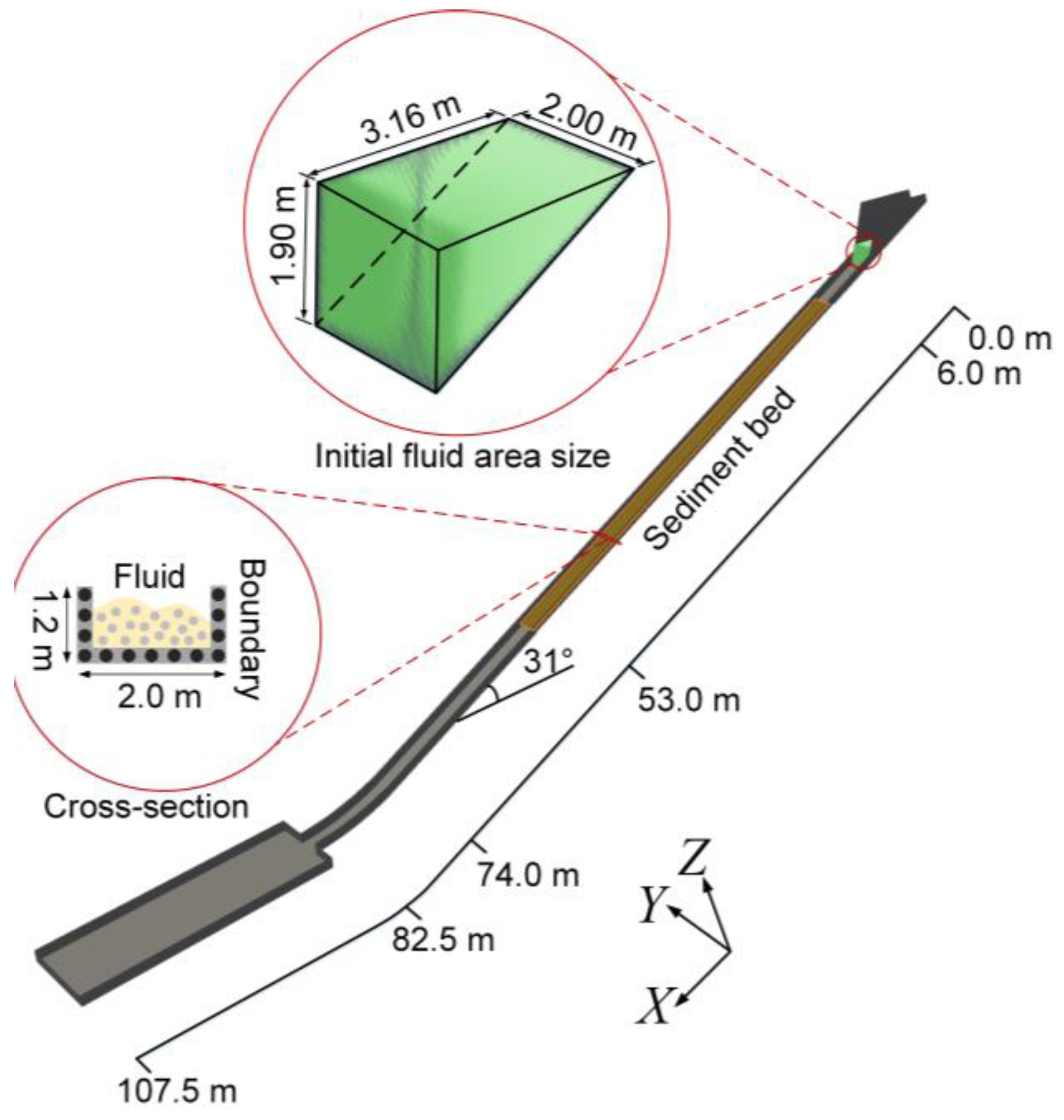
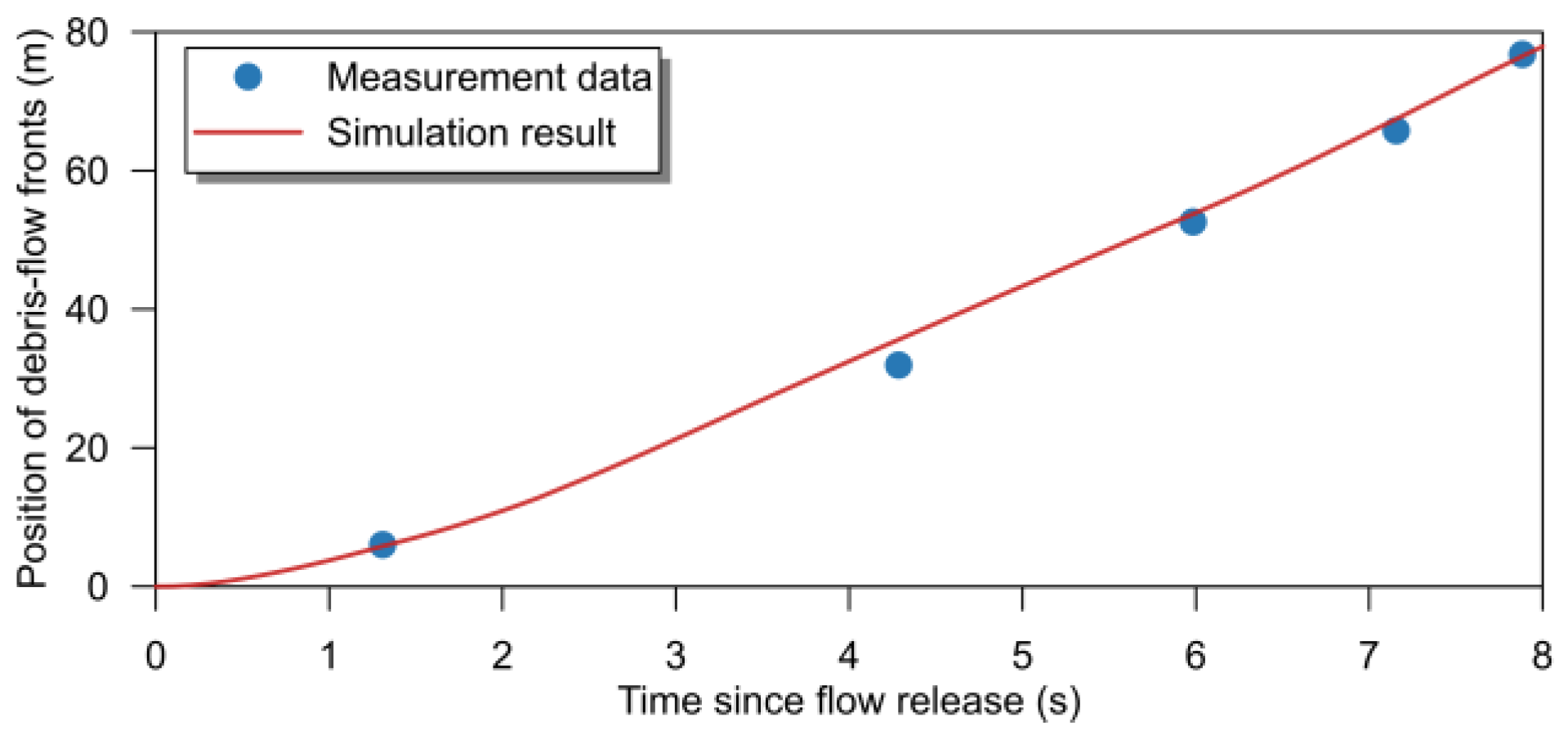



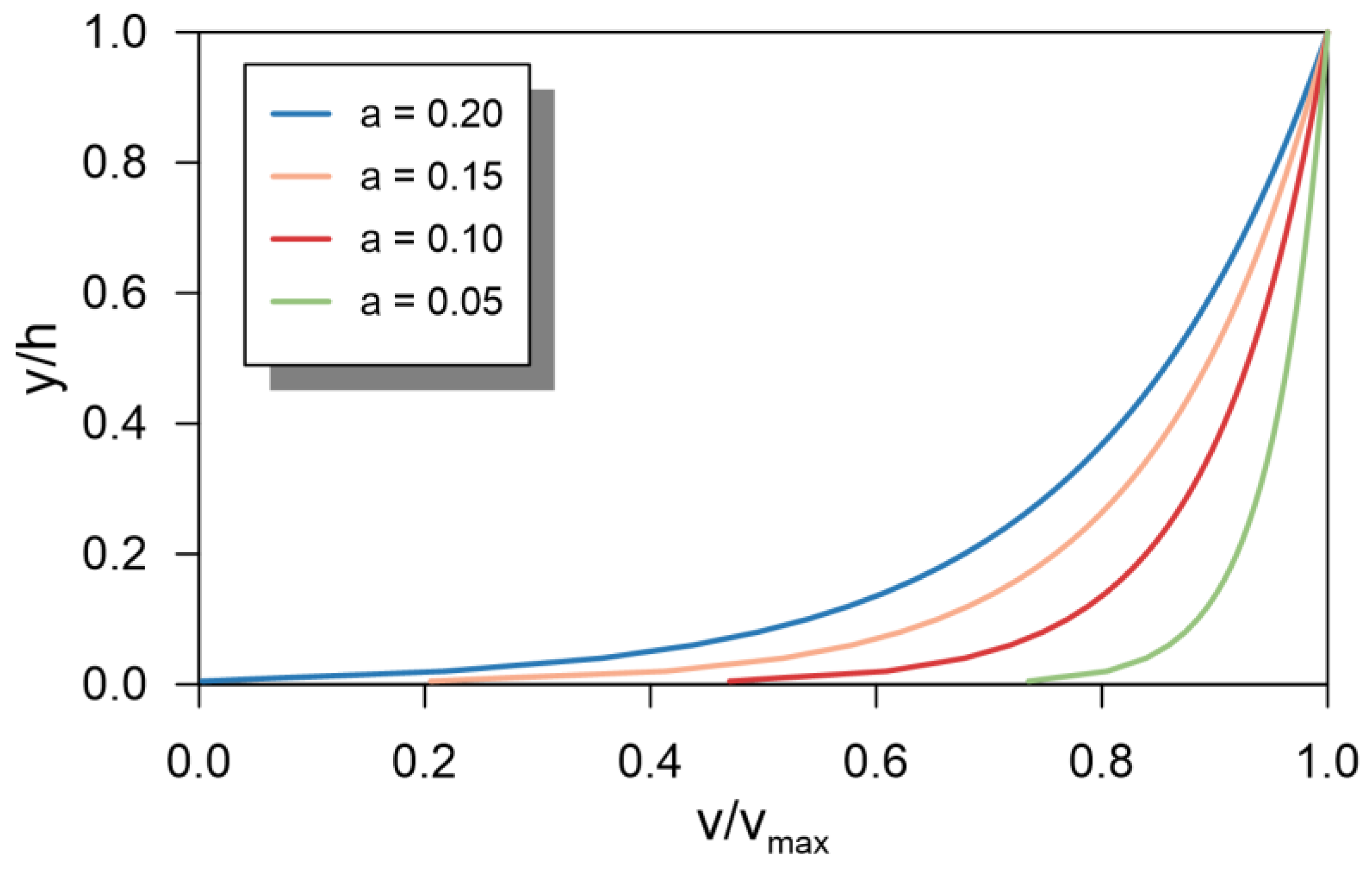
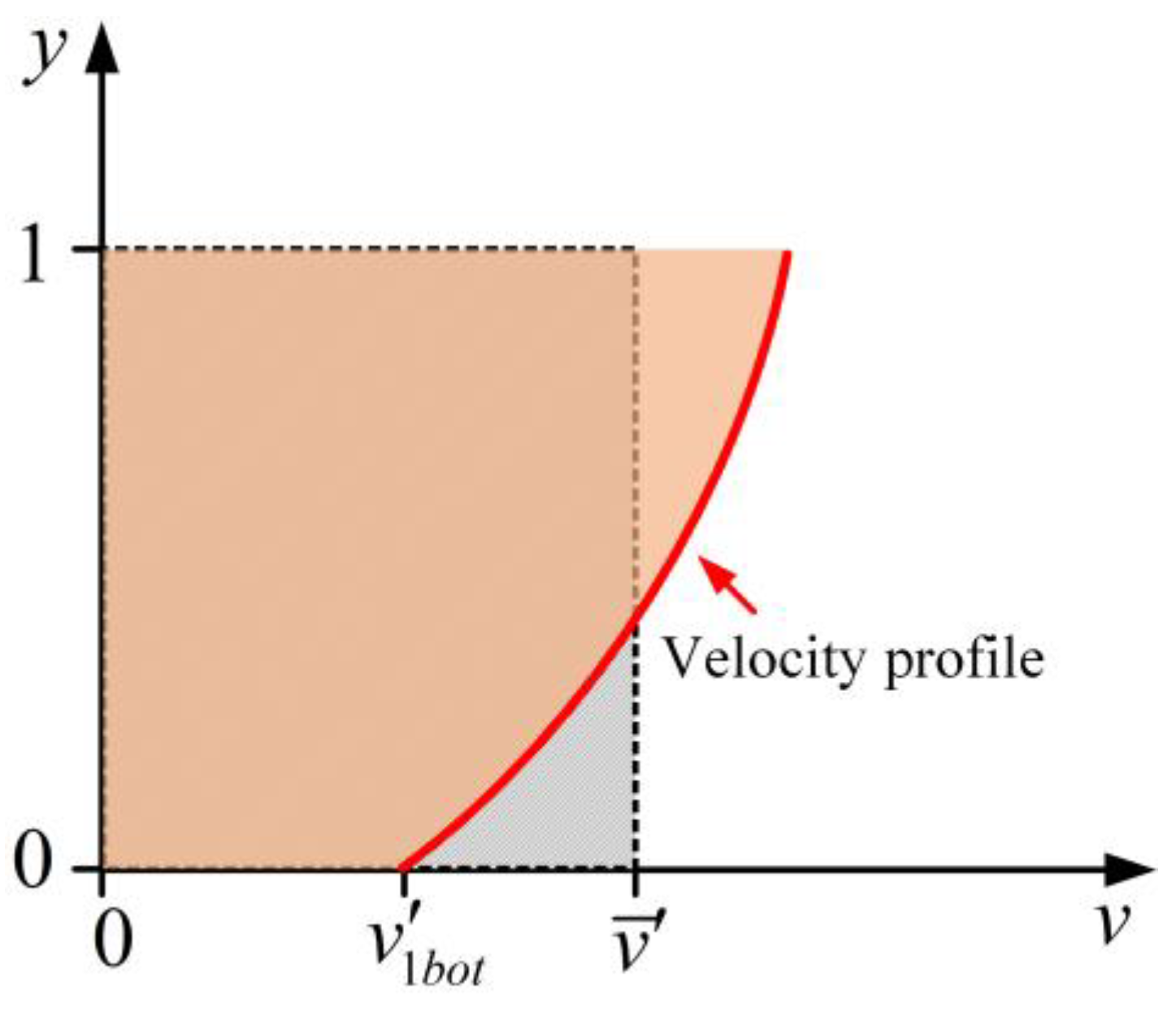

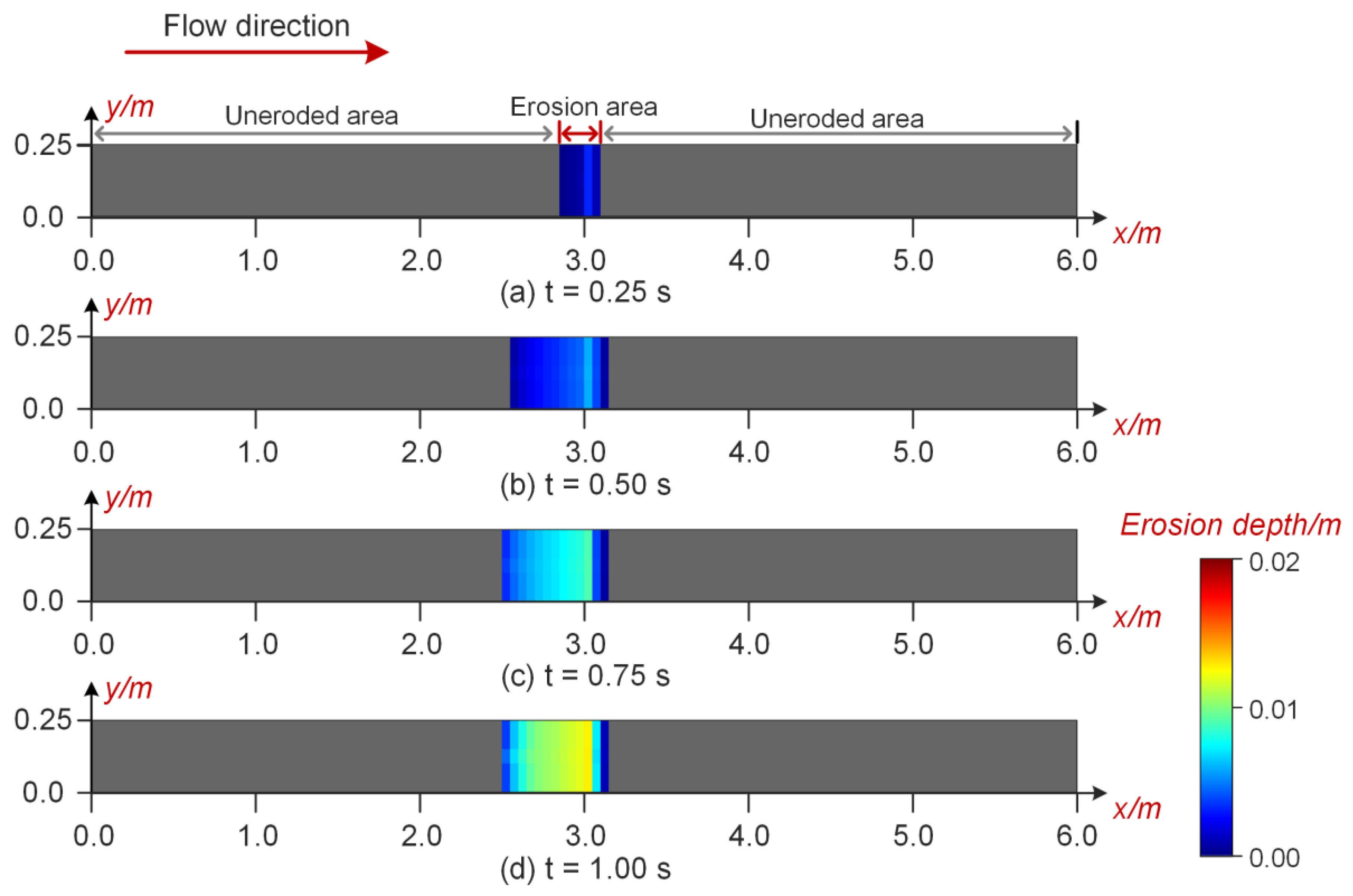

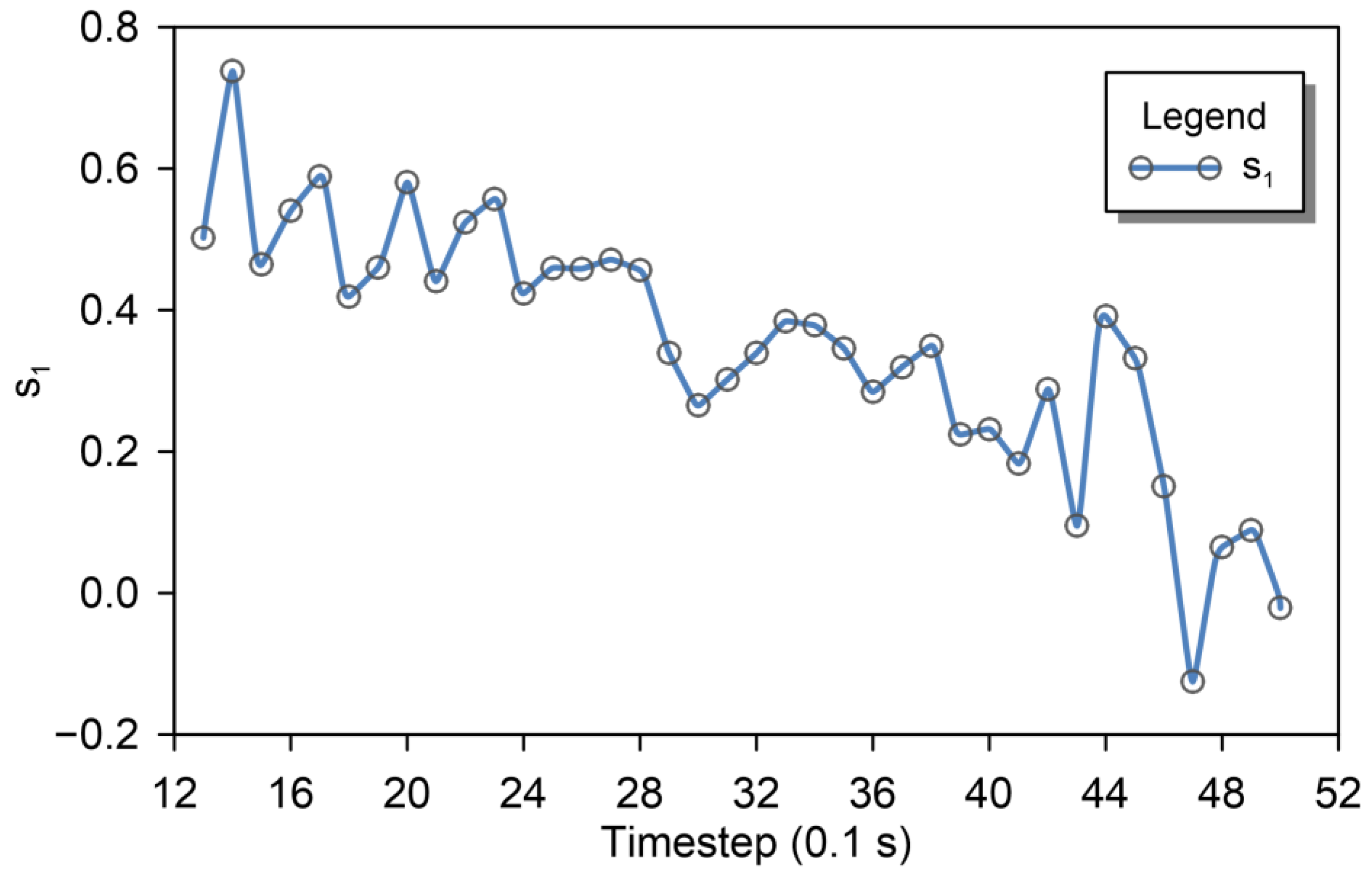
| Parameter | Notation | Unit | Value |
|---|---|---|---|
| Density of debris flow | kg/m3 | 1650 | |
| Apparent dynamic viscosity | Pa·s | 0.001 | |
| Yield strength | c | Pa | 0 |
| ° | 40 | ||
| Key coefficients of HBP model | / | 100 | |
| / | 1.00 | ||
| Particle distance | m | 0.04 | |
| Smoothing length | m | 0.0866 | |
| Total number of fluid particles | / | 87,591 | |
| Total number of boundary particles | / | 486,694 | |
| Debris flow duration | s | 25 | |
| Initial time interval | s | 0.00001 |
Publisher’s Note: MDPI stays neutral with regard to jurisdictional claims in published maps and institutional affiliations. |
© 2022 by the authors. Licensee MDPI, Basel, Switzerland. This article is an open access article distributed under the terms and conditions of the Creative Commons Attribution (CC BY) license (https://creativecommons.org/licenses/by/4.0/).
Share and Cite
Han, Z.; Zeng, C.; Li, Y. Hierarchical Statistics-Based Nonlinear Vertical Velocity Distribution of Debris Flow and Its Application in Entrainment Estimation. Water 2022, 14, 1352. https://doi.org/10.3390/w14091352
Han Z, Zeng C, Li Y. Hierarchical Statistics-Based Nonlinear Vertical Velocity Distribution of Debris Flow and Its Application in Entrainment Estimation. Water. 2022; 14(9):1352. https://doi.org/10.3390/w14091352
Chicago/Turabian StyleHan, Zheng, Chuicheng Zeng, and Yange Li. 2022. "Hierarchical Statistics-Based Nonlinear Vertical Velocity Distribution of Debris Flow and Its Application in Entrainment Estimation" Water 14, no. 9: 1352. https://doi.org/10.3390/w14091352






